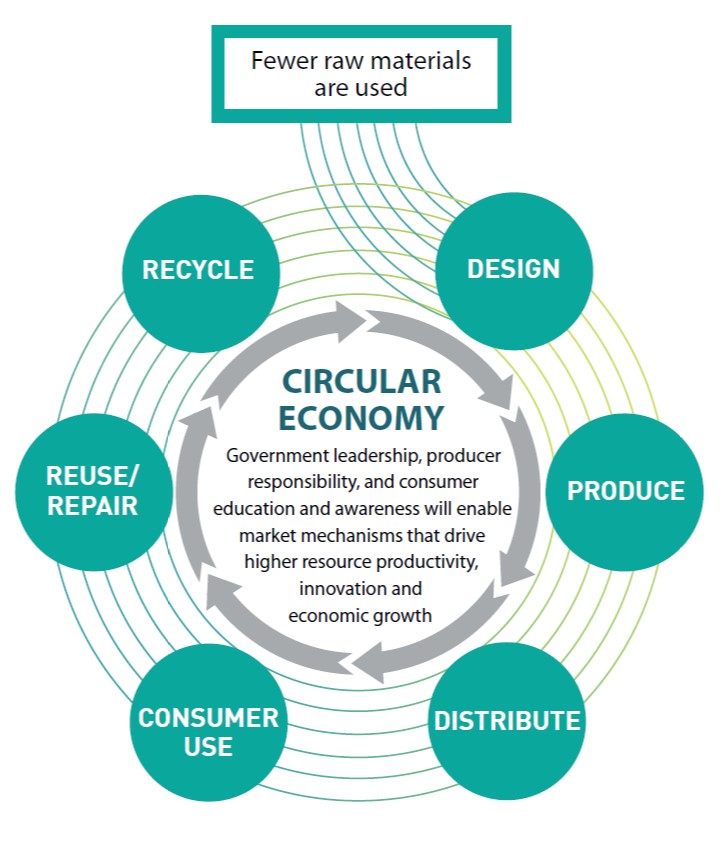Written by SK intern, Jadon Hook
Canada generated 11.5 million tonnes of waste in 2014 [1], which averages out to about a tonne of waste per person annually in Ontario. Only 25% of our waste this past decade has been recycled which means we are annually sending close to 8 million tonnes to landfills.
What is the solution to reducing our waste footprint? Transitioning into a circular economy.
What is a Circular Economy?
A circular economy is a sustainable model that looks to eliminate waste not just from the recycling process but in a resource or products lifecycle. Moving away from the traditional linear “make, use, and dispose” model, a circular economy looks to maximize our resources while minimizing our waste and footprint.
Fig. 1.1 [1]
Following these steps will increase waste reduction starting in the design of the products themselves. A company can design its products to have less packaging, use less raw materials, and reuse old materials so they are diverted from landfills.
Why Transition into a Circular Economy?
To meet environmental priorities moving towards a circular economy will drive businesses towards innovation, sustainable growth, and stimulate business development while diverting waste from landfills and maximizing current resources.
Companies integrating more sustainable designs into their products can reduce waste from excess packaging or unnecessary resources but that also results in cost savings which every business can get behind.
The circular economy model can create jobs, raise our gross domestic product (GDP), and save taxpayers money! According to Statistics Canada, local government expenses for waste is about $1.8 billion in 2004 to $3.2 billion in 2013. A study by Stats. Canada also said Ontario can create 10 times more jobs in waste diversion programs as opposed to waste disposal [2]. The study also estimated that 7 jobs are created every 1000 tonnes of waste diverted [2].
A circular economy encourages businesses to become more innovative and implement higher-quality and long-lasting features into product designs which can create better products for consumers to buy.
With the waste sector generating 6% of all greenhouse gas emissions (GHG) in Canada [1] this presents an opportunity to divert our Co2 emissions even further while promoting sustainable business development.
The Role of the Consumer
The circular economy does not just mean businesses changing but also a cultural shift in the consumers and individuals. Voting with your wallet has always and remains a consumer’s greatest asset to change how a business operates. Reward businesses who integrate sustainable practices with purchases instead of going for the cheaper option from a less sustainable source.
Saying no to plastic bags, straws, cutlery and using reusable options instead will stop businesses from purchasing these single-use plastic items and move towards innovative alternatives. You can find local businesses that use these practices on our Sustainabaly.eco map!
Other methods that consumers can follow to promote a circular economy are:
- Getting the most out of clothing and other products- repair, reuse, recycle
- Choose slow fashion-focused companies- What is slow fashion?
- Promoting the companies who strive to bring sustainable action
- Buy quality, over quantity
- Meal plan to avoid food waste
- Adapt a zero-waste lifestyle- guide on becoming zero-waste
How can we Achieve a Circular Economy?
Ontario specifically has outlined a goal and strategic plan for the transition into a circular economy you can read the full report here!
The goals are to achieve a zero-waste Ontario and achieve zero greenhouse gas emissions from the waste sector.
Implementing the 3Rs (reuse, reduce, recycle) into policy and legislation will ensure businesses start following these 3 key principles. Developing and promoting diversion campaigns while also utilizing current programs like the Blue Box program!
This switch will require a group effort from government leaders, businesses, and most importantly individuals who want a cleaner greener future.
References
[1] Ontario Government, "Strategy for a Waste-Free Ontario: Building the Circular Economy," 2017.
[2] Statistics Canada, "Waste Management Industry Study," Statistics Canada, 2004-2012.


